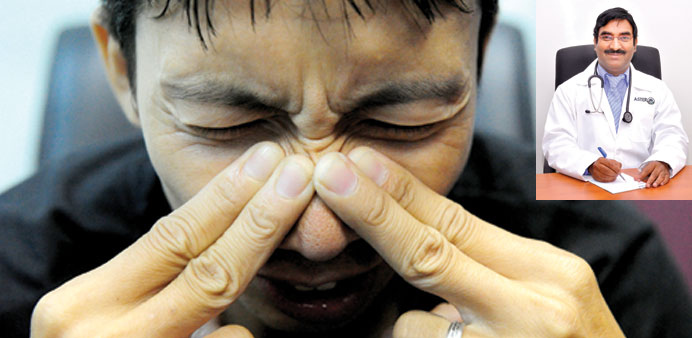By Dr Sakir Thurempurath
Acute sinusitis causes the cavities around your nasal passages (sinuses) to become inflamed and swollen. This interferes with drainage and causes mucus to build up.
With acute sinusitis, it may be difficult to breathe through your nose. The area around your eyes and face may feel swollen, and you may have throbbing facial pain or a headache.
Acute sinusitis is most often caused by the common cold. Other triggers include allergies, bacterial and fungal infections. Treatment of acute sinusitis depends on the cause. In most cases, home remedies are all that’s needed. However, persistent sinusitis can lead to serious infections and other complications. Sinusitis that lasts more than eight weeks or keeps coming back is called chronic sinusitis.
Symptoms
l Drainage of a thick, yellow or greenish discharge from the nose or down the back of the throat
l Nasal obstruction or congestion, causing difficulty breathing through your nose
l Pain, tenderness, swelling and pressure around your eyes, cheeks, nose or forehead
l Reduced sense of smell and taste
l Cough, which may be worse at night
l Other signs and symptoms can include:
l Ear pain
l Headache
l Aching in your upper jaw and teeth
l Bad breath
l Fatigue
l Fever
When to see a doctor
If you have mild symptoms of sinusitis, try self-care.
Contact your doctor if you have any symptoms that don’t improve within a few days or symptoms that get worse, a persistent fever and also in the case of history of recurrent or chronic sinusitis.
See a doctor immediately if you have signs or symptoms that may indicate a serious infection such as pain or swelling around your eyes, swollen forehead, severe headache, confusion, double vision or other vision changes, stiff neck and shortness of breath.
Causes
Viral infection — Most cases of acute sinusitis are caused by the common cold.
Bacterial infection — When an upper respiratory tract infection persists longer than seven to 10 days, it’s more likely to be caused by a bacterial infection than by a viral infection.
Fungal infection — You’re at increased risk of a fungal infection if you have sinus abnormalities or a weakened immune system.
Some health conditions can increase your risk of getting a sinus infection that causes sinusitis, or can increase your risk of getting sinusitis that isn’t caused by an underlying infection. These conditions include:
Allergies such as hay fever — Inflammation that occurs with allergies may block your sinuses.
Nasal polyps or tumors — These tissue growths may block the nasal passages or sinuses.
Deviated nasal septum — A crooked septum, the wall between the nostrils, may restrict or block sinus passages.
Tooth infection – A small number of cases of acute sinusitis are caused by an infected tooth.
Other medical conditions — The complications of cystic fibrosis, gastroesophageal reflux disease (GERD) or immune system disorders may result in blocked sinuses or an increased risk of infection.
Risk factors
You may be at increased risk of getting sinusitis if you have:
Hay fever or another allergic condition that affects your sinuses
A nasal passage abnormality, such as a deviated nasal septum, nasal polyps or tumors
A medical condition such as cystic fibrosis, GERD or an immune system disorder such as immunoglobulin or antibody deficiency.
Regular exposure to pollutants such as cigarette smoke.
Complications
Acute sinusitis complications include:
Asthma flare-ups – Acute sinusitis can trigger an asthma attack.
Chronic sinusitis — Acute sinusitis may be a flare-up of a long-term problem known as chronic sinusitis. Chronic sinusitis is sinusitis that lasts longer than eight weeks.
Meningitis — This occurs when infection spreads to the lining of the brain.
Vision problems — If infection spreads to your eye socket, it can cause reduced vision or even blindness. This is a medical emergency that requires immediate treatment to prevent potentially permanent damage.
Ear infection — Acute sinusitis may occur with an ear infection.
Tests and diagnosis
Your doctor may use several methods to help screen for acute sinusitis, such as:
Physical exam — To look for the cause of your symptoms, your doctor will feel for tenderness in your nose or throat. Your doctor may use a tool to hold your nose open and apply medication that constricts blood vessels in your nasal passages. This makes it easier to see inside your nasal passages.
Your doctor will then shine a light into your nasal passages to look for inflammation or fluid. This visual inspection will also help rule out physical conditions that trigger sinusitis, such as nasal polyps or other abnormalities.
Nasal endoscopy — A thin, flexible tube (endoscope) with a fiber-optic light inserted through your nose allows your doctor to visually inspect the inside of your sinuses.
Imaging studies — Images taken using computerised tomography (CT) or magnetic resonance imaging (MRI) can show details of your sinuses and nasal area. While not recommended for uncomplicated acute sinusitis, imaging studies may help identify abnormalities or suspected complications.
Nasal and sinus cultures — Laboratory tests are generally unnecessary for diagnosing acute sinusitis. However, in cases in which the condition fails to respond to treatment or is progressing, tissue cultures may help pinpoint the cause, such as identifying a bacterial cause.
Allergy testing — If your doctor suspects that the condition may be brought on by allergies, an allergy skin test may be recommended. A skin test is safe and quick, and can help pinpoint the allergen that’s responsible for your nasal flare-up.
Treatments and drugs
Most cases of acute sinusitis don’t need treatment because they’re caused by viruses that also cause the common cold. Self-care techniques are usually the only treatment needed to speed recovery and ease symptoms.
Treatments to relieve symptoms
Nasal corticosteroids — These nasal sprays help prevent and treat inflammation.
Decongestants — These medications are available in over-the-counter (OTC) and prescription liquids, tablets and nasal sprays. OTC oral decongestants include Sudafed, Actifed and Drixoral. Nasal sprays include oxymetazoline (Afrin, others). These medications are generally taken for only a few days at most. Otherwise, they can cause the return of more severe congestion (rebound congestion).
Over-the-counter pain relievers, such as aspirin, acetaminophen (Tylenol, others) or ibuprofen (Advil, Motrin IB, others).
Antibiotics
Antibiotic treatment is generally needed only if the infection is severe, recurrent or persistent. Antibiotics used to treat acute sinusitis caused by a bacterial infection include amoxicillin (Amoxil, others), doxycycline (Doryx, Monodox, others) or the combination drug trimethoprim-sulfamethoxazole (Bactrim, Septra, others). If the infection doesn’t go away or if the sinusitis comes back, your doctor may try a different antibiotic.
If your doctor does prescribe antibiotics, it’s critical to take the entire course of medication. Generally, this means you’ll need to take them for 10 to 14 days, even after your symptoms get better. If you stop taking them early, your symptoms may come back.
Antifungal medications
Acute sinusitis is caused by a fungal infection, which can be treated with antifungal medication. The dose of medication, as well as how long you’ll need to take it depends on the severity of your infection and how quickly your symptoms improve.
Immunotherapy
If allergies are contributing to your sinusitis, allergy shots (immunotherapy) that help reduce the body’s reaction to specific allergens may help treat your symptoms.
Lifestyle and home remedies
These self-help steps can help relieve sinusitis symptoms:
Get plenty of rest. This will help your body fight infection and speed recovery.
Drink plenty of fluids, such as water or juice. This will help dilute mucous secretions and promote drainage. Avoid beverages that contain caffeine or alcohol, as they can be dehydrating. Drinking alcohol can also worsen the swelling of the lining of the sinuses and nose.
Moisten your sinus cavities. Drape a towel over your head as you breathe in the vapor from a bowl of hot water. Keep the vapor directed toward your face. Or take a hot shower, breathing in the warm, moist air. This will help ease pain and help mucus drain.
Apply warm compresses to your face. Place warm, damp towels around your nose, cheeks and eyes to ease facial pain.
Rinse out your nasal passages. Use a specially designed squeeze bottle (Sinus Rinse, others) or neti pot to rinse your nasal passages. This home remedy, called nasal lavage, can help clear your sinuses. If you make your own rinse, use water that’s contaminant-free — distilled, sterile, previously boiled and cooled, or filtered using a filter with an absolute pore size of 1 micron or smaller to make up the irrigation solution. Also be sure to rinse the irrigation device after each use with contaminant-free water and leave open to air-dry.
Sleep with your head elevated. This will help your sinuses drain, reducing congestion.
Prevention
Take these steps to help reduce your risk of getting acute sinusitis:
Avoid upper respiratory infections. Minimise contact with people who have colds. Wash your hands frequently with soap and water, especially before your meals.
Carefully manage your allergies. Work with your doctor to keep symptoms under control.
Avoid cigarette smoke and polluted air. Tobacco smoke and other pollutants can irritate and inflame your lungs and nasal passages.
Use a humidifier. If the air in your home is dry, such as it is if you have forced-air heat, adding moisture to the air may help prevent sinusitis. Be sure the humidifier stays clean and free of mold with regular, thorough cleaning.
Dr Sakir Thurempurath
MBBS, PG Dip. (Family Medicine)
Family Physician
Aster Medical Centre, Al Rayyan
For clarifications, please contact:[email protected]

Dr Sakir Thurempurath (Inset)


